




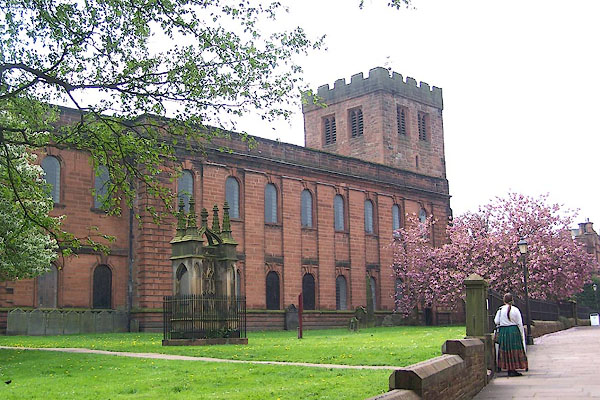
BMC51.jpg (taken 12.5.2006)
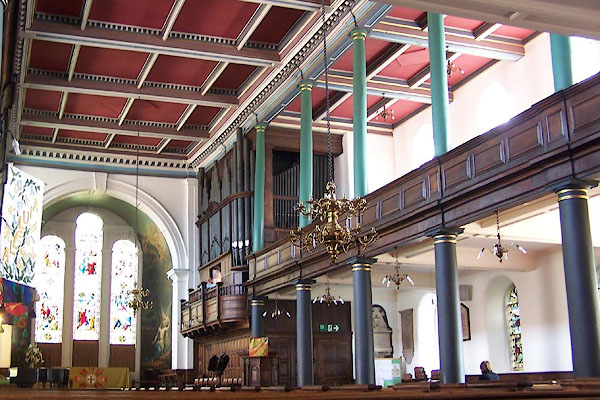
BMC53.jpg (taken 12.5.2006)
placename:- St Andrew's Church
"St. Andrew's Ch. (Vicarage)"
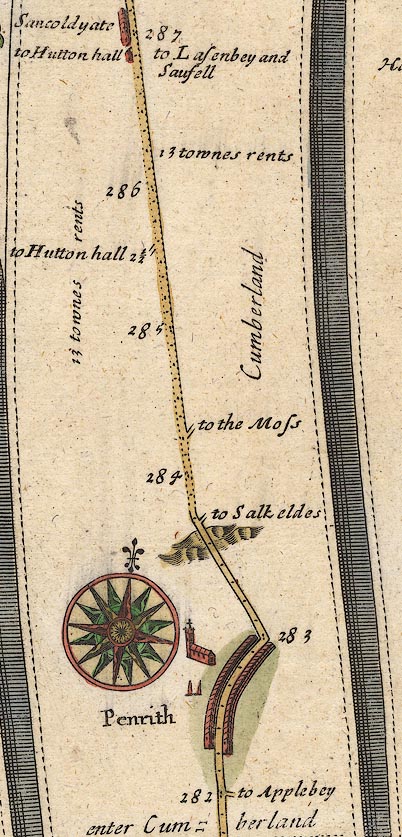
OG38m282.jpg
In mile 282, Cumberland.
Church to the left of the road, behind the houses.
item:- JandMN : 21
Image © see bottom of page
item:- turret clock; clock; star; Zodiac; moon movement
"... there was also on the Church at Peroth a fine Clock which had severall motions, there was the starrs and signes there was the encrease and changes of the moone by a darke and golden side of a little globe."
item:- plaque
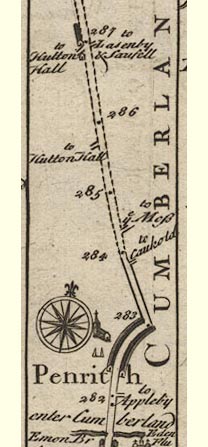
B094m282.jpg
"The Church is a very Spacious & Fine Structure, remarkable for a Latin Inscription on the North outside of ye Vestry Wall, Signifying yt in the Year 1508 there was a raging Plague in this County which Destroyed grt. Numbers of People in this &ye Adjacent Towns, of wch. our Historians take not the least Notice. In King Henry 8ths. time it was Honoured with ye Title of a Suffragan Bishop. In ye Church Yard on ye North Side of ye Church, are 2 large Pillars, ..."
item:- Dove Cottage : 2007.38.100
Image © see bottom of page
placename:-
item:- plague
"... On the north side of the vestry of this church [Penrith] is erected in the wall an ancient square stone, with a memorial, intimating that in the year 1598 there was a dreadful plague in those parts, in which there dy'd;"
"Persons. / In Kendal, 2500 / In Penrith, 2266 / In Richmond, 2200 / In Carlisle, 1196 / 8162"
"N.B. By this account it should seem that every one of those towns had separately more people than the city of Carlisle, and that Kendal, which is the only manufacturing town of them, was the most populous."
item:- plague; black death
 goto source
goto source"..."
"... The Church is an handsome spacious Edifice, but hath nothing further remarkable but an Inscription in rude Characters, set up for a Monument to Posterity, upon the N. Outside of the Vestry Wall: Fuit Pestis, &c. i.e. There was a Plague in this County in 1598, whereof died at Kendal, 2500; at Richmond, 2200; at Penrith, 2266; and at Carlisle, 1196: Which Relation is the more observable, and worth our Notice, because we have no Account of this Accident in any of our Histories. In King Henry VIII's Days, it was honour'd with the Title of a Suffragen Bishop."
item:- 1745 Rebellion; Battle of Clifton Moor
 goto source
goto sourcepage 16:- "..."
"The church of Penrith is vicarial, and is worth, (as appears from the table of donations,) about L.100 per annum; it is in the gift of the Bishop of Carlisle, having been annexed to that See at its first erection by King Henry the I. It is a very handsome modern structure, having been rebuilt A.D. 1721, the tower excepted, which is of a much older and uncertain date. It consists internally of 112 pews on the ground, and 90 in the galleries, which are supported upon 20 beautiful stone pillars, well worth the notice of travellers: each pillar consists of one single stone, veined like mahogany, or stained fir; insomuch that they seem rather to have grown like wood, than to have been cut out of a solid block."
"The whole inside of the church is elegantly neat, the pews being made in a variegated English oak, and the altar decorated all round with paintings, which will be a lasting testament of the abilities of Mr Reid. From the roof of the Church depend two handsome gilt chandeliers, with the following inscription upon them: "These chandeliers were purchased with the 50 guineas given by the most noble William Duke of Portland to his tenants of the honour of Penrith, who, under his Grace's encouragement, associated in defence of the Government and town of Penrith against the rebels in 1745." The rebels, after their retreat from Derby, were put to flight from Clifton and Penrith, by his Royal Highness William Duke of Cumberland, after a short skirmish near Clifton-Moor, which began about four o'clock in the afternoon of Wednesday December 18th 1745: The rebel prisoners taken by the tenants of Penrith and the neighbours were upwards of 80."
item:- excommunication
 goto source
goto sourcepage 21:- "..."
"Before I leave Penrith, I must mention two pieces of church-history which occurred too late to be inserted in their proper place. ... The other is this; In the year 1355, some persons having committed several outrages in the church and church-yard of Penrith, Bishop Walton issued out a mandate to Sir Thomas rector of Burgham, and John de Docwray, threatening the greater excommunication to all concerned therein. Upon this, several of the parishioners went to Rose Castle and owned themselves guilty to the Bishop, humbly begging pardon, and intreating him to withdraw his mandate. This he consented to, upon condition that each of them should make an offering be-"
 goto source
goto sourcePage 22:- "[be]fore the image of the blessed Virgin, the Sunday following, of a wax candle three pounds weight."
 goto source
goto sourcePage 188:- "... The church was rebuilt of brick 1720, except the steeple. ..."
 goto source
goto source"[Penrith] ... The church is a large and handsome structure, mostly new built, except the lower part. Its roof is supported by pillars, consisting each of one entire stone dug out of a neighbouring quarry. ..."
 goto source
goto sourceGentleman's Magazine 1819 part 1 p.508
From the Compendium of County History:- "... The vicarage [Penrith] was enjoyed from 1699 till his death in 1728 by Dr. Hugh Todd, who made considerable topographical collections for this county, and wrote a brief account of Carlisle."
 goto source
goto sourcePage 131:- "..."
"The parish church, dedicated to St. Andrew, is a large structure, rebuilt in 1722, by a rate and subscription: the tower, which contains a set of very sweet chimes, is ancient. In the churchyard is a curious relic of antiquity, called the Giant's Grave, consisting of two large pillars, ten feet in height, and distant fifteen feet from each other in the direction of east and west, having the space between them partly enclosed on each side by four large thin stones. Near them is another pillar named the Giant's Thumb, but it is six feet in height. ..."
placename:- St Andrew's Church
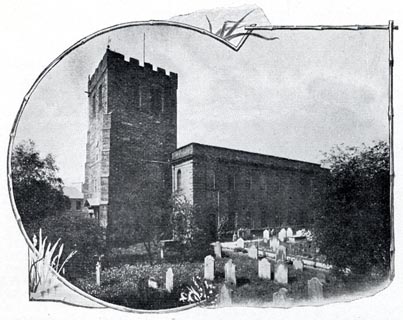 click to enlarge
click to enlargeUN105.jpg
item:- JandMN : 1023.5
Image © see bottom of page
placename:-
HP01p132.txt
Page 132:- "..."
"There is not much left of the ancient church of Penrith, beside its Gothic tower, for the body of the building dates"
HP01p133.txt
Page 133:- "only from 1722, and is in a classic style that seems rank heresy in a place so historic as this. Not even the monolithic Ionic columns of red marble that decorate the interior, nor the ornate gilded chandeliers presented by the Duke of Portland, in recognition of the loyalty of Penrith in 1745, can compensate the stranger for the loss; although, to be sure, the townsfolk are inordinately proud of them. But there are many ancient monuments in the church, and some interesting fragments of stained glass that have escaped destruction. Among them is represented golden-haired Cicely Neville, youngest of all the two-and-twenty children of Henry Neville, Earl of Westmoreland. This is that "Proud Cis of Raby" who was wife of Richard, Duke of York, and mother of Edward the Fourth and Richard the Third. Here, too, is seen a plaguey ill-favoured stained-glass "likeness" of Richard the Second, with hair of an unpleasant canary-yellow, and a couple of chin-sprouts of the same colour."
"Still upon three sides of the church-tower you see sculptured the "bear and ragged staff" device of the great Earl of Warwick, the King-maker, who in his time was lord of Penrith and rebuilt the upper stage of the tower; ..."
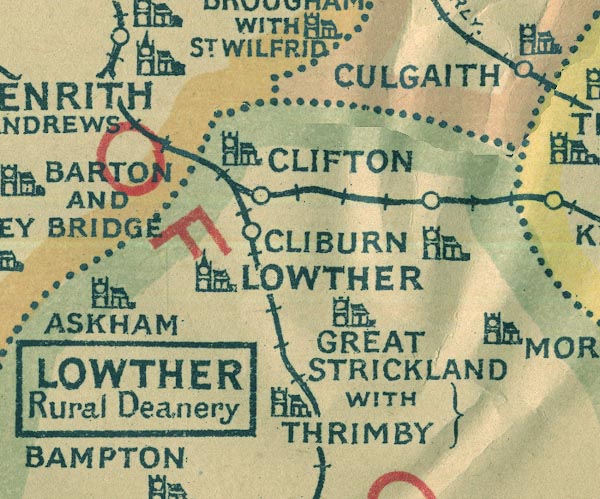
NUR1NY52.jpg
"PENRITH"
item:- JandMN : 27
Image © see bottom of page
 stained glass
stained glassplacename:- Parish Church of St Andrew
courtesy of English Heritage
"PARISH CHURCH OF ST ANDREW / / ST ANDREW'S CHURCHYARD / PENRITH / EDEN / CUMBRIA / I / 72923 / NY5164730156"
courtesy of English Heritage
"Red sandstone rubble west tower of C12 and C13. The west doorway and rest of church was rebuilt in 1720 in red sandstone ashlar, classical. Two rows of round-headed windows in chamfered openings and with triple keystones. Sundial on south wall. Interior has 2 tiers of Roman Doric arcades, wide aisles, and galleries of equal width over the aisles and at west. Panelled ceilings. Three round-headed lights in east wall. Round arched over altar, with paintings."
courtesy of English Heritage
"MONUMENT TO RAILWAY CONTRACTORS IN ST ANDREW'S CHURCHYARD ON NORTH SIDE OF CHURCH / / ST ANDREW'S CHURCHYARD / PENRITH / EDEN / CUMBRIA / II / 72924 / NY5165930184"
courtesy of English Heritage
"1846. Victorian Gothic monument to commemorate building of Lancaster to Carlisle Railway. Robert Virtue, superintendent, John Stephenson &Co. Stone. Two rectangular piers with pointed arched panels with inscriptions, ending at top in crocketted finials. Between the piers is Perpendicular Gothic tracery, cusped, with an ogee arch above ending in a foliated finial."
 click to enlarge
click to enlargeRSN102.jpg
Tipped in opposite p.4 of Wordsworthshire by Eric Robertson.
printed at bottom:- "SKIDDAW AND BLENCATHRA, SEEN FROM THE SIDE OF PENRITH BEACON / (In foreground and middle distance, Scumshaw Farm, Church and Castle of Penrith)"
item:- JandMN : 197.2
Image © see bottom of page
 ring of bells
ring of bells cross slab gravestones
cross slab gravestones| Nevill, Ralph de | 1215 - |
| Penreth, Simon de | 1222 - |
| Cantelupe, Walter de | 1223 - |
| Kirkoswald, Thomas de, Sir | 1318 - up to |
| Horncastle, Alan de, Sir | 1318 - 1323 |
| Kirkby, Gilbert de, Sir | 1323 - 1325 |
| Wormynton, Peter de | 1325 - |
| Penreth, John de | 1332 - |
| Penreth, John de, Sir | 1355 - |
| Roter, John | 1387 - |
| Bolton, Hugh de | 1390 - |
| Strickland, William | 1399 - |
| Hanekin, John | 1428 - |
| Best, Thomas | 1477 - |
| Beneman, Henry | 1535 - |
| Sawell, Thomas | 1536 - |
| Ellerton, Thomas, Sir | 1565 - |
| Pearson, Robert, Sir | 1565 - 11574 |
| Robson, Robert, Sir | 1574 - 1575 |
| Walleis, William, Sir | 1575 - 1601 |
| Hastie, John | 1601 - 1650 |
| Baldwin, Roger | 1650 - 1660 |
| Webster, Simon | 1660 - 1663 |
| Fisher, Robert | 1663 - 1665 |
| Carter, Charles | 1665 - 1667 |
| d'Assigny, Marius | 1667 - 1668 |
| Bunting, Joshua | 1668 - |
| Child, John | - 1694 |
| Farington, Alexander | 1694 - 1699 |
| Todd, Hugh | 1699 - 1728 |
| Morland, John | 1728 - 1748 |
| Thompson, Gustavus | 1748 - 1749 |
| Worsop, Battie | 1749 - 1750 |
| Cowper, John | 1750 - 1788 |
| Grisdale, Browne | 1788 - 1790 |
| Fletcher, James | 1790 - 1823 |
| Fenton, John | 1823 - 1833 |
| Jackson, William | 1833 - 1841 |
| Clark, Thomas James | 1841 - 1845 |
| Milner, William Holme | 1845 - 1853 |
| Butler, Samuel Johnston | 1853 - 1879 |
| Chapman, Edward William | 1879 - 1888 |
| Monnington, Thomas Pateshall | 1888 - 1905 |
| Cropper, James | 1905 - 1911 |
 sundial
sundial sundial (2)
sundial (2) sundial (3)
sundial (3)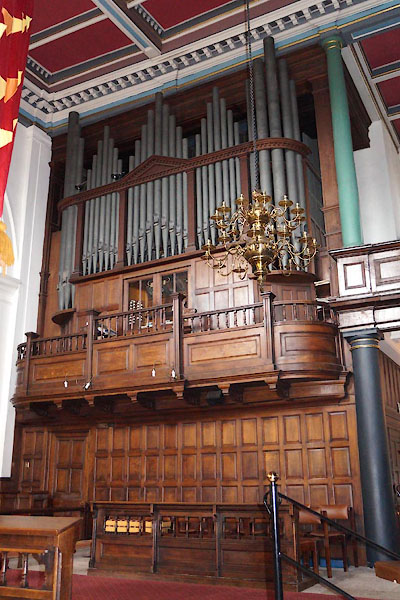
CAT64.jpg Organ
(taken 23.5.2014)

BVR95.jpg Mother Union banner
(taken 22.11.2011)
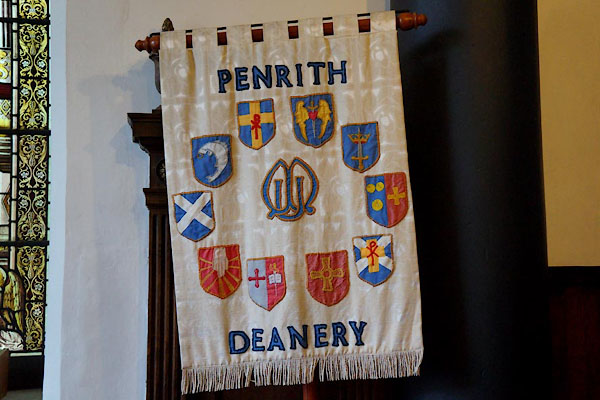
CAT63.jpg Mothers Union banner; at St Andrew's, Penrith:-
"PENRITH DEANERY" (taken 23.5.2014)
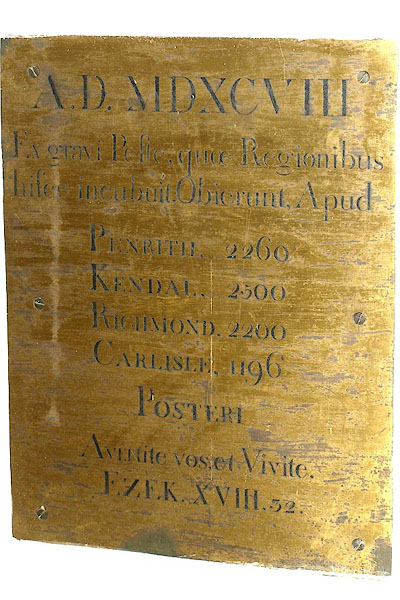
BQU24.jpg Brass plaque in the tower, restates what has been defaced by time from a sandstone plaque:-
"A.D. MDXCVIII Ex gravi Peste, quoe Regionibus hisce incubuit, Obierunt, Apud / PENRITH, 2260 / KENDAL, 2500 / RICHMOND, 2200 / CARLISLE, 1196 / POSTERI Averite vo, et Vivite / EZEK. XVIII.32." (taken 11.6.2009)
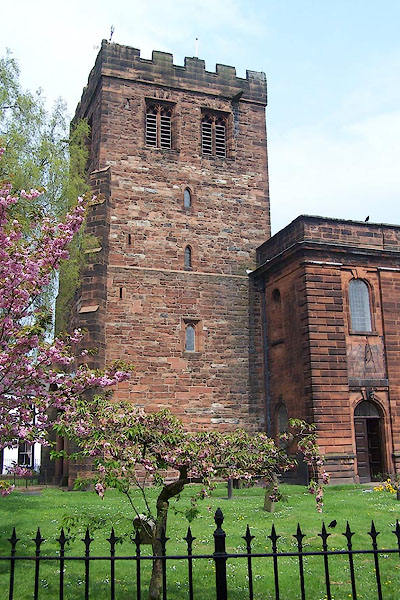
BMC50.jpg (taken 12.5.2006)
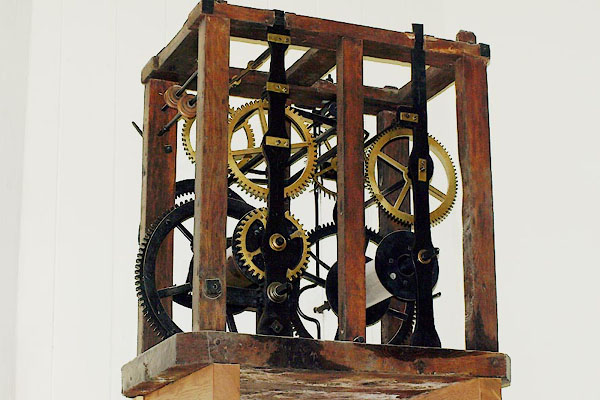
BQU22.jpg Movement of turret clock, displayed in the tower. The clock was built by Aaron Cheesbrough, Penrith, 1712; wood framed, dead beat escapement, strike train.
(taken 11.6.2009)

BQU23.jpg Movement of turret clock, displayed in the tower. The clock was built by Aaron Cheesbrough, Penrith, 1712; wood framed, dead beat escapement, strike train.
(taken 11.6.2009)
